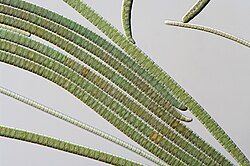| Oscillatoria | |
|---|---|
 | |
| Oscillatoria princeps | |
| Scientific classification | |
| Domain: | Bacteria |
| Kingdom: | Bacillati |
| Phylum: | Cyanobacteriota |
| Class: | Cyanophyceae |
| Order: | Oscillatoriales |
| Family: | Oscillatoriaceae |
| Genus: | Oscillatoria Vaucher ex Gomont, 1822 |
| Type species | |
| Oscillatoria princeps Vaucher ex Gomont | |
| Species | |
See list in body text | |

Oscillatoria is a genus of filamentous cyanobacteria. It is often found in freshwater environments. [1] Its name refers to the oscillating motion of its filaments as they slide against each other to position the colony to face a light source. [2] Oscillatoria uses photosynthesis to survive and reproduce. Each filament of Oscillatoria consists of a row of cells called a trichome. The tip of the trichome oscillates like a pendulum.
Contents
Reproduction takes place asexually by fragmentation. Usually the filament breaks into a number of fragments called hormogonia. Each hormogonium consist of one or more cells and grows into a filament by cell division in one direction. Hormogonia has capacity for locomotion. [1]
As a result of recent genetic analyses, several new genera were erected from this genus, e.g. Tenebriella . [3]